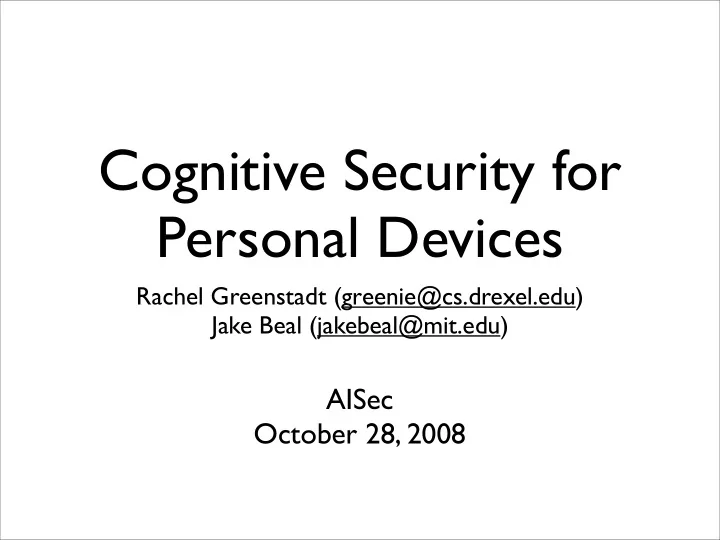

Cognitive Security for Personal Devices Rachel Greenstadt (greenie@cs.drexel.edu) Jake Beal (jakebeal@mit.edu) AISec October 28, 2008
I must be dancing with Jake, after all, this guy knows Jake’s private key....
Sounds like Jake Looks like Jake Dances like Jake Human-style authentication
Computers could recognize other cues Typing patterns T Touchpad patterns Camera image Use patterns Posture/Device placement It seems this is Mako and not, in fact, Jake
Cognitive Security • Humans have rich and subtle mechanisms for handling trust and security • Goal: Intelligent agents mediate security decisions between users and applications • Build user models via continuously-deployed multi-modal behavioral biometrics • Use models to aid security decisions
Mismatch Between Users and Machines: An AI and HCI Problem • We must use human mechanisms sometimes • Example: passwords to keys • Security automation considered harmful? [Edwards Poole Stoole 2007] • Context dependent security decisions • Can’t be pre-baked in • Need an agent to observe the context
Machine Imprint on Users, develop models of their behavior Obviously not appropriate for all scenarios...
Architecture for Machine Integrity • Sensitive Information • Requires isolation • Lots of research in this sort of model already • Overhead? (VMMs, classifiers, etc) perhaps...
Once computers know their users, they can infer beliefs and goals Alice’s device: Alice: * Knows she wants to visit * Knows Alice is not her bank visiting her bank * Doesn’t know she’s not * Doesn’t know that Alice at her bank believes she is at her bank
Adjustably Autonomous Security • Model users’ belief, desires, intentions • Understand concepts • private information • expected program behavior • simulate users’ judgment • pass decisions up when appropriate
Current work • Authentication • Keystrokes • Stylometry • Anti-phishing
Thank You • Questions? • More detail available as MIT CSAIL Tech Report 2008-016 • http://dspace.mit.edu/handle/1721.1/40810 • Email: greenie@cs.drexel.edu, jakebeal@mit.edu
Recommend
More recommend